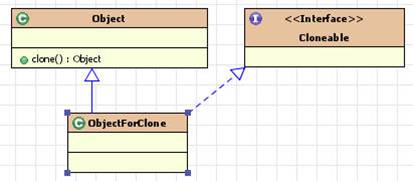ÕŁ”õ╣ĀÕÅéĶĆā’╝Ü
http://www.cnblogs.com/hegezhou_hot/archive/2010/12/04/1896471.html
Õ«Üõ╣ē’╝ܵś»õĖĆń¦ŹÕłøÕ╗║Õ×ŗĶ«ŠĶ«Īµ©ĪÕ╝Å,Õ«āķĆÜĶ┐ćÕżŹÕłČõĖĆõĖ¬ÕĘ▓ń╗ÅÕŁśÕ£©ńÜäÕ«×õŠŗµØźĶ┐öÕø×µ¢░ńÜäÕ«×õŠŗ,ĶĆīõĖŹµś»µ¢░Õ╗║Õ«×õŠŗ.Ķó½ÕżŹÕłČńÜäÕ«×õŠŗÕ░▒µś»µłæõ╗¼µēĆń¦░ńÜäÕĤÕ×ŗ,Ķ┐ÖõĖ¬ÕĤÕ×ŗµś»ÕŻիÜÕłČńÜä.
ķćŹńé╣’╝Ü
1ŃĆüÕĤÕ×ŗµ©ĪÕ╝ÅõĖ╗Ķ”üńö©õ║ÄÕ»╣Ķ▒ĪńÜäÕżŹÕłČ’╝īPrototypeµ©ĪÕ╝ÅÕģüĶ«ĖõĖĆõĖ¬Õ»╣Ķ▒ĪÕåŹÕłøÕ╗║ÕÅ”Õż¢õĖĆõĖ¬ÕŻիÜÕłČńÜäÕ»╣Ķ▒Ī’╝īµĀ╣µ£¼µŚĀķ£Ćń¤źķüōõ╗╗õĮĢÕ”éõĮĢÕłøÕ╗║ńÜäń╗åĶŖéŃĆé
2ŃĆüõĮ┐ńö©ÕĤÕ×ŗµ©ĪÕ╝ÅÕłøÕ╗║Õ»╣Ķ▒Īµ»öńø┤µÄźnewõĖĆõĖ¬Õ»╣Ķ▒ĪÕ£©µĆ¦ĶāĮõĖŖĶ”üÕźĮńÜäÕżÜ’╝īÕøĀõĖ║Objectń▒╗ńÜäcloneµ¢╣µ│Ģµś»õĖĆõĖ¬µ£¼Õ£░µ¢╣µ│Ģ’╝īÕ«āńø┤µÄźµōŹõĮ£ÕåģÕŁśõĖŁńÜäõ║īĶ┐øÕłČµĄü’╝īńē╣Õł½µś»ÕżŹÕłČÕż¦Õ»╣Ķ▒ĪµŚČ’╝īµĆ¦ĶāĮńÜäÕĘ«Õł½ķØ×ÕĖĖµśÄµśŠ
Õ║öńö©Õ£║µÖ»’╝ÜÕĤÕ×ŗµ©ĪÕ╝ÅÕżÜńö©õ║ÄÕłøÕ╗║ÕżŹµØéńÜ䵳¢ĶĆģĶĆŚµŚČńÜäÕ«×õŠŗ, ÕøĀõĖ║Ķ┐Öń¦ŹµāģÕåĄõĖŗ,ÕżŹÕłČõĖĆõĖ¬ÕĘ▓ń╗ÅÕŁśÕ£©ńÜäÕ«×õŠŗÕÅ»õ╗źõĮ┐ń©ŗÕ║ÅĶ┐ÉĶĪīµø┤ķ½śµĢł,µł¢ĶĆģÕłøÕ╗║ÕĆ╝ńøĖńŁē,ÕŬµś»ÕæĮÕÉŹõĖŹõĖƵĀĘńÜäÕÉīń▒╗µĢ░µŹ«.
ń▒╗ÕøŠ’╝Ü

JDKõĖŁńÜäõĮōńÄ░’╝Ü
Object.clone’╝øCloneable

class Prototype implements Cloneable {
public Prototype clone(){
Prototype prototype = null;
try{
prototype = (Prototype)super.clone();
}catch(CloneNotSupportedException e){
e.printStackTrace();
}
return prototype;
}
}
class ConcretePrototype extends Prototype{
public void show(){
System.out.println("ÕĤÕ×ŗµ©ĪÕ╝ÅÕ«×ńÄ░ń▒╗");
}
}
public class Client {
public static void main(String[] args){
ConcretePrototype cp = new ConcretePrototype();
ConcretePrototype clonecp = (ConcretePrototype)cp.clone();
clonecp.show();
}
}
ĶŠōÕć║’╝Ü
ÕĤÕ×ŗµ©ĪÕ╝ÅÕ«×ńÄ░ń▒╗
µē®Õ▒Ģ’╝Ü
1ŃĆücloneµ¢╣µ│Ģµ×äķĆĀńÜäÕ»╣Ķ▒Īµś»µ▓Īµ£ēĶ░āńö©µ×äķĆĀµ¢╣µ│ĢńÜä
class Prototype implements Cloneable {
public Prototype clone() {
Prototype prototype = null;
try {
prototype = (Prototype) super.clone();
} catch (CloneNotSupportedException e) {
e.printStackTrace();
}
return prototype;
}
}
class ConcretePrototype extends Prototype {
private static int i = 0;
public ConcretePrototype() {
i++;
}
public void show() {
System.out.println("ÕĤÕ×ŗµ©ĪÕ╝ÅÕ«×ńÄ░ń▒╗" + i);
}
}
public class Test {
public static void main(String[] args) {
ConcretePrototype cp = new ConcretePrototype();
ConcretePrototype clonecp = (ConcretePrototype) cp.clone();
System.out.println(cp == clonecp);
System.out.println(cp.equals(clonecp));
cp.show();
clonecp.show();
}
}
ĶŠōÕć║’╝Ü
false
false
ÕĤÕ×ŗµ©ĪÕ╝ÅÕ«×ńÄ░ń▒╗1
ÕĤÕ×ŗµ©ĪÕ╝ÅÕ«×ńÄ░ń▒╗1
Õ”éµ×£µś»ĶĄ░õ║åµ×äķĆĀµ¢╣µ│Ģ’╝īclonecp.show();Õ║öĶ»źĶŠōÕć║2
2ŃĆüÕ╝Ģńö©ÕŬõ╝ÜĶ┐øĶĪīµĄģµŗĘĶ┤Ø (prototype ÕÆī clone ńÜäÕ╝Ģńö©Õ«×õŠŗ’╝ܵś»ÕÉīõĖĆõĖ¬Õ»╣Ķ▒Ī)
class P implements Cloneable {
public P clone() {
P prototype = null;
try {
prototype = (P) super.clone();
} catch (CloneNotSupportedException e) {
e.printStackTrace();
}
return prototype;
}
}
/**
* Õ╝Ģńö©ÕŬõ╝ÜĶ┐øĶĪīµĄģµŗĘĶ┤Ø,
* @author xinchun.wang
*/
public class A extends P {
private List<String> list = new ArrayList<String>();
private String s = "s";
public static void main(String[] args) {
A a = new A();
A ca = (A)a.clone();
System.out.println(a.equals(ca));//false
System.out.println(a.list == ca.list); //true
a.list.add("aaa");
System.out.println(ca.list); //[aaa]
System.out.println("---------------------------");
System.out.println("a.s: " + a.s);//a.s:s
System.out.println("ca.s: " + ca.s);//ca.s: s
a.s = "b";
System.out.println("a.s: " + a.s);//a.s: b
System.out.println("ca.s: " + ca.s);//ca.s: s
}
}
3ŃĆüµĘ▒µŗĘĶ┤ØõĖĵĄģµŗĘĶ┤Ø
Objectń▒╗ńÜäcloneµ¢╣µ│ĢÕŬõ╝ܵŗĘĶ┤ØÕ»╣Ķ▒ĪõĖŁńÜäÕ¤║µ£¼ńÜäµĢ░µŹ«ń▒╗Õ×ŗ’╝ł8ń¦ŹÕ¤║µ£¼µĢ░µŹ«ń▒╗Õ×ŗbyte,char,short,int,long,float,double’╝īboolean’╝ē’╝īÕ»╣õ║ĵĢ░ń╗äŃĆüÕ«╣ÕÖ©Õ»╣Ķ▒ĪŃĆüÕ╝Ģńö©Õ»╣Ķ▒ĪńŁēķāĮõĖŹõ╝ܵŗĘĶ┤Ø’╝īĶ┐ÖÕ░▒µś»µĄģµŗĘĶ┤ØŃĆéÕ”éµ×£Ķ”üÕ«×ńÄ░µĘ▒µŗĘĶ┤Ø’╝īÕ┐ģķĪ╗Õ░åÕĤÕ×ŗµ©ĪÕ╝ÅõĖŁńÜäÕ╝Ģńö©Õ»╣Ķ▒Ī’╝łµĢ░ń╗äŃĆüÕ«╣ÕÖ©Õ»╣Ķ▒Ī’╝ēÕÅ”ĶĪīµŗĘĶ┤ØŃĆé

õĖŠõŠŗ’╝Ü
public class Prototype implements Cloneable {
private ArrayList list = new ArrayList();
public Prototype clone(){
Prototype prototype = null;
try{
prototype = (Prototype)super.clone();
prototype.list = (ArrayList) this.list.clone();
}catch(CloneNotSupportedException e){
e.printStackTrace();
}
return prototype;
}
}
µ│©µäÅ’╝Üńö▒õ║ÄArrayListõĖŹµś»Õ¤║µ£¼ń▒╗Õ×ŗ’╝īµēĆõ╗źµłÉÕæśÕÅśķćÅlist’╝īõĖŹõ╝ÜĶó½µŗĘĶ┤Ø’╝īķ£ĆĶ”üµłæõ╗¼Ķć¬ÕĘ▒Õ«×ńÄ░µĘ▒µŗĘĶ┤Ø’╝īÕ╣ĖĶ┐ÉńÜ䵜»javaµÅÉõŠøńÜäÕż¦ķā©ÕłåńÜäÕ«╣ÕÖ©ń▒╗ķāĮÕ«×ńÄ░õ║åCloneableµÄźÕÅŻŃĆéµēĆõ╗źÕ«×ńÄ░µĘ▒µŗĘĶ┤ØÕ╣ČõĖŹµś»ńē╣Õł½Õø░ķÜŠŃĆé
õ╗źõĖŗµś» ArrayListńÜäcloneÕ«×ńÄ░’╝īÕģČõ╗¢Õ╝Ģńö©Õ«×ńÄ░ÕÅ»õ╗źÕÅéĶĆā’╝Ü
public Object clone() {
try {
ArrayList<E> v = (ArrayList<E>) super.clone();
v.elementData = Arrays.copyOf(elementData, size);
v.modCount = 0;
return v;
} catch (CloneNotSupportedException e) {
// this shouldn't happen, since we are Cloneable
throw new InternalError();
}
}
4ŃĆüµĘ▒µŗĘĶ┤ØńÜäÕ«×ńÄ░õĖŠõŠŗ’╝Ü
class P implements Cloneable {
}
/**
* @author xinchun.wang
*/
public class A extends P {
@SuppressWarnings("unchecked")
public A clone() {
A prototype = null;
try {
prototype = (A) super.clone();
prototype.list = (List<String>) ((ArrayList<String>)(this.list)).clone();
} catch (CloneNotSupportedException e) {
e.printStackTrace();
}
return prototype;
}
private List<String> list = new ArrayList<String>();
public static void main(String[] args) {
A a = new A();
A ca = a.clone();
a.list.add("aaaa");
System.out.println(a.list); //[aaaa]
System.out.println(ca.list);//[]
}
}
Ķ┐śµ£ēõĖĆń¦Źµ¢╣Õ╝Å’╝Ü
Õ║ÅÕłŚÕī¢Õ«×ńÄ░’╝īµŖŖÕ»╣Ķ▒ĪÕåÖķüōµĄüķćīńÜäĶ┐ćń©ŗµś»õĖ▓ĶĪīÕī¢(Serilization)Ķ┐ćń©ŗ;µŖŖÕ»╣Ķ▒Īõ╗ĵĄüõĖŁĶ»╗Õć║µØźµś»Õ╣ČĶĪīÕī¢(Deserialization)Ķ┐ćń©ŗ. ÕåÖÕ£©µĄüķćīńÜ䵜»Õ»╣Ķ▒ĪńÜäõĖĆõĖ¬µŗĘĶ┤Ø,ńäČÕÉÄÕåŹõ╗ĵĄüķćīĶ»╗Õć║µØźķćŹÕ╗║Õ»╣Ķ▒Ī.
public class PrototypeSe implements Serializable {
private String name;
public String getName() {
return name;
}
public void setName(String name) {
this.name = name;
}
}
public class NewPrototypeSe implements Serializable {
private String id;
public String getId() {
return id;
}
public void setId(String id) {
this.id = id;
}
private PrototypeSe prototype;
public PrototypeSe getPrototype() {
return prototype;
}
public void setPrototype(PrototypeSe prototype) {
this.prototype = prototype;
}
public Object deepClone(){
try {
ByteArrayOutputStream bo = new ByteArrayOutputStream();
ObjectOutputStream oo = new ObjectOutputStream(bo);
oo.writeObject(this);
ByteArrayInputStream bi = new ByteArrayInputStream(bo.toByteArray());
ObjectInputStream oi = new ObjectInputStream(bi);
return oi.readObject();
} catch (IOException | ClassNotFoundException e) {
// TODO Auto-generated catch block
e.printStackTrace();
return null;
}
}
}
public class TestDeepClone {
public static void main(String[] args) {
// TODO Auto-generated method stub
PrototypeSe po = new PrototypeSe();
po.setName("test1");
NewPrototypeSe se = new NewPrototypeSe();
se.setPrototype(po);
NewPrototypeSe deepClone = (NewPrototypeSe)se.deepClone();
deepClone.getPrototype().setName("test2");
System.out.println("original name:" + se.getPrototype().getName());
System.out.println("cloned name:" + deepClone.getPrototype().getName());
}
}
ń╗ōµ×£:
original name:test1
cloned name:test2

- Õż¦Õ░Å: 13.1 KB

- Õż¦Õ░Å: 38.9 KB
Õłåõ║½Õł░’╝Ü















ńøĖÕģ│µÄ©ĶŹÉ
Ōö£ŌöĆń¼¼õĖĆń½Ā µŚŁńæČ-Õ░ŵ╗┤...Ōöé┬Ā5.1-ÕłøÕ╗║Õ×ŗĶ«ŠĶ«Īµ©ĪÕ╝Å-PrototypeÕĤÕ×ŗĶ«ŠĶ«Īµ©ĪÕ╝ÅÕ«×µłśŃĆŖõĖŖŃĆŗ.mp4 Ōöé┬Ā5.2-ÕłøÕ╗║Õ×ŗĶ«ŠĶ«Īµ©ĪÕ╝Å-PrototypeÕĤÕ×ŗĶ«ŠĶ«Īµ©ĪÕ╝ÅÕ«×µłśŃĆŖõĖŗŃĆŗ.mp4 Ōöé┬Ā6.1-µÄźÕÅŻõ╣ŗķŚ┤ńÜäµĪźµóü-ķĆéķģŹÕÖ©Ķ«ŠĶ«Īµ©ĪÕ╝ÅõĮĀń¤źķüōÕżÜÕ░æ.mp4 Ōöé┬Ā6.4
C#Ķ«ŠĶ«Īµ©ĪÕ╝Å’╝ł9’╝ē’╝ŹPrototype Pattern C#Ķ«ŠĶ«Īµ©ĪÕ╝Å’╝ł8’╝ē’╝ŹBuilder Pattern C#Ķ«ŠĶ«Īµ©ĪÕ╝Å’╝ł7’╝ē’╝ŹSingleton Pattern C#Ķ«ŠĶ«Īµ©ĪÕ╝Å’╝ł6’╝ē’╝ŹAbstract Factory Pattern C#Ķ«ŠĶ«Īµ©ĪÕ╝Å’╝ł5’╝ē’╝ŹFactory Method Pattern C#Ķ«ŠĶ«Īµ©ĪÕ╝Å’╝ł4’╝ē...
Ķ«ŠĶ«Īµ©ĪÕ╝Åõ╣ŗPrototype
1.1 õ╗Ćõ╣łµś»Ķ«ŠĶ«Īµ©ĪÕ╝Å 2 1.2 Smalltalk MVC õĖŁńÜäĶ«ŠĶ«Īµ©ĪÕ╝Å 3 1.3 µÅÅĶ┐░Ķ«ŠĶ«Īµ©ĪÕ╝Å 4 1.4 Ķ«ŠĶ«Īµ©ĪÕ╝ÅńÜäń╝¢ńø« 5 1.5 ń╗äń╗ćń╝¢ńø« 7 1.6 Ķ«ŠĶ«Īµ©ĪÕ╝ŵĆĵĀĘĶ¦ŻÕå│Ķ«ŠĶ«ĪķŚ«ķóś 8 1.6.1 Õ»╗µēŠÕÉłķĆéńÜäÕ»╣Ķ▒Ī 8 1.6.2 Õå│Õ«ÜÕ»╣Ķ▒ĪńÜäń▓ÆÕ║” 9 1.6.3 µīćÕ«ÜÕ»╣Ķ▒Ī...
23ń¦ŹĶ«ŠĶ«Īµ©ĪÕ╝Åõ╣ŗPrototypeµ©ĪÕ╝Åõ╗ŻńĀü’╝īĶ┐Öµś»Ķć¬ÕĘ▒ÕŁ”õ╣ĀPrototypeµ©ĪÕ╝ÅķĪ║ÕĖ”ÕåÖńÜäõ╗ŻńĀü’╝īõ╗ģõŠøÕŁ”õ╣Āõ║żµĄü
JAVAĶ«ŠĶ«Īµ©ĪÕ╝Å-day2’╝īĶ»ĘńÜäĶĪīõĖÜÕż¦ĶāĮĶ«▓ÕŠŚĶ»Šń©ŗ’╝īµČēÕÅŖ’╝ÜÕłøÕ╗║µ©ĪÕ╝Å’╝ł5ń¦Ź’╝Ü 1ŃĆü ÕĘźÕÄéµ¢╣µ│Ģµ©ĪÕ╝Å’╝łFactory Method’╝ē’╝ø 2ŃĆü µŖĮĶ▒ĪÕĘźÕÄ鵩ĪÕ╝Å’╝ø 3ŃĆü ÕŹĢõŠŗµ©ĪÕ╝Å’╝łSingleton’╝ē ŌĆó 4ŃĆü Õ╗║ķĆĀĶĆģµ©ĪÕ╝Å’╝łBuilder’╝ē’╝ø 5ŃĆü ÕĤÕ×ŗµ©ĪÕ╝Å’╝łPrototype...
Prototypeµ©ĪÕ╝Å ÕŹ│ÕĤÕ×ŗµ©ĪÕ╝Å’╝īµÅÉõŠøõĖĆõĖ¬ÕĘ▓ń╗ÅÕŁśÕ£©ńÜäÕ»╣Ķ▒ĪĶ┐øĶĪīµ¢░Õ»╣Ķ▒ĪÕłøÕ╗║ńÜäµÄźÕÅŻ’╝īõĖĆĶł¼µāģÕåĄõĖŗķāĮµś»õĮ┐ńö©CloneµÄźÕÅŻŃĆé µŁżµ©ĪÕ╝ÅķØ×ÕĖĖń«ĆÕŹĢ’╝īń«ĆÕŹĢńÜäĶ»┤Õ░▒µś»ÕżŹÕłČÕżÜõĖ¬ÕĮōÕēŹÕ»╣Ķ▒ĪõŠøõĮ┐ńö©ŃĆéPrototypeµ©ĪÕ╝ÅÕģüĶ«ĖõĖĆõĖ¬Õ»╣Ķ▒ĪÕåŹÕłøÕ╗║ÕÅ”Õż¢õĖĆõĖ¬ÕŻիÜÕłČ...
Ķ«ŠĶ«Īµ©ĪÕ╝Åń▓ŠĶ¦Ż’╝ŹGoF 23 ń¦ŹĶ«ŠĶ«Īµ©ĪÕ╝ÅĶ¦Żµ×ÉķÖä C++Õ«×ńÄ░µ║ÉńĀü ńø« ÕĮĢ Õ╝Ģ Ķ©Ć 0.1 Ķ«ŠĶ«Īµ©ĪÕ╝ÅĶ¦Żµ×É’╝łµĆ╗Õ║Å) 0.2 Ķ«ŠĶ«Īµ©ĪÕ╝ÅĶ¦Żµ×ÉÕÉÄĶ«░ 0.3 õĖÄõĮ£ĶĆģĶüöń│╗ 1 ÕłøÕ╗║Õ×ŗµ©ĪÕ╝Å 1.1 Factoryµ©ĪÕ╝Å 1.2 AbstactFactoryµ©ĪÕ╝Å 1.3 Singleton...
Ķć│õ║Äń¼¼14ń½ĀÕłÖÕŠłÕ┐½Õ£░µĄÅĶ¦łÕ░ܵ£¬õ╗ŗń╗ŹńÜäĶ«ŠĶ«Īµ©ĪÕ╝Å’╝īÕīģµŗ¼BridgeŃĆüBuilderŃĆüChain of ResponsibilityŃĆüFlyweightŃĆüInterpreterŃĆüMediatorŃĆüMementoŃĆüPrototype’╝īVisitorŃĆéń¼¼1ń½ĀĶ┐śõ╗ŗń╗Źõ║åÕøøõĖ¬ŌŚŗŌŚŗÕ¤║µ£¼µ”éÕ┐Ą(µŖĮĶ▒ĪŃĆüÕ░üĶŻģŃĆüń╗¦µē┐ŃĆü...
NULL ÕŹÜµ¢ćķōŠµÄź’╝Ühttps://wy649898543.iteye.com/blog/1431591
ProtoType.rarProtoType.rarProtoType.rarÕĤÕ×ŗĶ«ŠĶ«Īµ©ĪÕ╝Å
IOSĶ«ŠĶ«Īµ©ĪÕ╝ŵĄģµ×Éõ╣ŗÕĤÕ×ŗµ©ĪÕ╝Å(Prototype)--copy - iOSń¤źĶ»åÕ║ō1
1.2 Smalltalk MVCõĖŁńÜäĶ«ŠĶ«Īµ©ĪÕ╝Å 1.3 µÅÅĶ┐░Ķ«ŠĶ«Īµ©ĪÕ╝Å 1.4 Ķ«ŠĶ«Īµ©ĪÕ╝ÅńÜäń╝¢ńø« 1.5 ń╗äń╗ćń╝¢ńø« 1.6 Ķ«ŠĶ«Īµ©ĪÕ╝ŵĆĵĀĘĶ¦ŻÕå│Ķ«ŠĶ«ĪķŚ«ķóś 1.7 µĆĵĀĘķĆēµŗ®Ķ«ŠĶ«Īµ©ĪÕ╝Å 1.8 µĆĵĀĘõĮ┐ńö©Ķ«ŠĶ«Īµ©ĪÕ╝Å ń¼¼õ║īń½Ā Õ«×õŠŗńĀöń®Č’╝ÜĶ«ŠĶ«ĪõĖĆõĖ¬µ¢ćµĪŻń╝¢ĶŠæÕÖ© 2.1 Ķ«ŠĶ«ĪķŚ«ķóś...
ŃĆŖńĀöńŻ©Ķ«ŠĶ«Īµ©ĪÕ╝ÅŃĆŗÕ«īµĢ┤Ķ”åńø¢GoFĶ«▓Ķ┐░ńÜä23õĖ¬Ķ«ŠĶ«Īµ©ĪÕ╝ÅÕ╣ČÕŖĀõ╗źń╗åń╗åńĀöńŻ©ŃĆéÕłØń║¦ÕåģÕ«╣õ╗ÄÕ¤║µ£¼Ķ«▓ĶĄĘ’╝īÕīģµŗ¼µ»ÅõĖ¬µ©ĪÕ╝ÅńÜäÕ«Üõ╣ēŃĆüÕŖ¤ĶāĮŃĆüµĆØĶĘ»ŃĆüń╗ōµ×äŃĆüÕ¤║µ£¼Õ«×ńÄ░ŃĆüĶ┐ÉĶĪīĶ░āńö©ķĪ║Õ║ÅŃĆüÕ¤║µ£¼Õ║öńö©ńż║õŠŗńŁē’╝īĶ«®Ķ»╗ĶĆģĶāĮń│╗ń╗¤ŃĆüÕ«īµĢ┤ŃĆüÕćåńĪ«Õ£░µÄīµÅĪµ»ÅõĖ¬µ©ĪÕ╝Å’╝ī...
ŃĆŖńĀöńŻ©Ķ«ŠĶ«Īµ©ĪÕ╝ÅŃĆŗÕ«īµĢ┤Ķ”åńø¢GoFĶ«▓Ķ┐░ńÜä23õĖ¬Ķ«ŠĶ«Īµ©ĪÕ╝ÅÕ╣ČÕŖĀõ╗źń╗åń╗åńĀöńŻ©ŃĆéÕłØń║¦ÕåģÕ«╣õ╗ÄÕ¤║µ£¼Ķ«▓ĶĄĘ’╝īÕīģµŗ¼µ»ÅõĖ¬µ©ĪÕ╝ÅńÜäÕ«Üõ╣ēŃĆüÕŖ¤ĶāĮŃĆüµĆØĶĘ»ŃĆüń╗ōµ×äŃĆüÕ¤║µ£¼Õ«×ńÄ░ŃĆüĶ┐ÉĶĪīĶ░āńö©ķĪ║Õ║ÅŃĆüÕ¤║µ£¼Õ║öńö©ńż║õŠŗńŁē’╝īĶ«®Ķ»╗ĶĆģĶāĮń│╗ń╗¤ŃĆüÕ«īµĢ┤ŃĆüÕćåńĪ«Õ£░µÄīµÅĪµ»ÅõĖ¬µ©ĪÕ╝Å’╝ī...
ŃĆŖńĀöńŻ©Ķ«ŠĶ«Īµ©ĪÕ╝ÅŃĆŗÕ«īµĢ┤Ķ”åńø¢GoFĶ«▓Ķ┐░ńÜä23õĖ¬Ķ«ŠĶ«Īµ©ĪÕ╝ÅÕ╣ČÕŖĀõ╗źń╗åń╗åńĀöńŻ©ŃĆéÕłØń║¦ÕåģÕ«╣õ╗ÄÕ¤║µ£¼Ķ«▓ĶĄĘ’╝īÕīģµŗ¼µ»ÅõĖ¬µ©ĪÕ╝ÅńÜäÕ«Üõ╣ēŃĆüÕŖ¤ĶāĮŃĆüµĆØĶĘ»ŃĆüń╗ōµ×äŃĆüÕ¤║µ£¼Õ«×ńÄ░ŃĆüĶ┐ÉĶĪīĶ░āńö©ķĪ║Õ║ÅŃĆüÕ¤║µ£¼Õ║öńö©ńż║õŠŗńŁē’╝īĶ«®Ķ»╗ĶĆģĶāĮń│╗ń╗¤ŃĆüÕ«īµĢ┤ŃĆüÕćåńĪ«Õ£░µÄīµÅĪµ»ÅõĖ¬µ©ĪÕ╝Å’╝ī...
Ķ«ŠĶ«Īµ©ĪÕ╝Åń▓ŠĶ¦Ż’╝Ź GoF 23 ń¦ŹĶ«ŠĶ«Īµ©ĪÕ╝ÅĶ¦Żµ×ÉķÖä C++Õ«×ńÄ░µ║ÉńĀü ńø« ÕĮĢ 0 Õ╝ĢĶ©Ć ...........................................................................................................................................
µł¢ÕģČõ╗¢ÕŠłķģĘńÜäõĖ£Ķź┐’╝ē bower install app-prototype Õ╣ČõĮ£õĖ║NodeJSÕīģapplication-prototype sudo npm install -g application-prototypeÕĮōÕēŹÕ»╣Ķ▒ĪÕ║öńö©ń©ŗÕ║ÅĶ«ŠĶ«Īµ©ĪÕ╝ÅńÜäµ×äÕ╗║ÕÖ©’╝ø µ¢ćõ╗ČÕ║öńö©ń©ŗÕ║ÅĶ«ŠĶ«Īµ©ĪÕ╝ÅńÜäµ×äÕ╗║ÕÖ©’╝īÕ«āķ£ĆĶ”üÕż¦ķćÅ...
NULL ÕŹÜµ¢ćķōŠµÄź’╝Ühttps://hnzhoujunmei.iteye.com/blog/1032892
Ķ«ŠĶ«Īµ©ĪÕ╝ÅC++ÕŁ”õ╣Āõ╣ŗÕĤÕ×ŗµ©ĪÕ╝Å(Prototype)